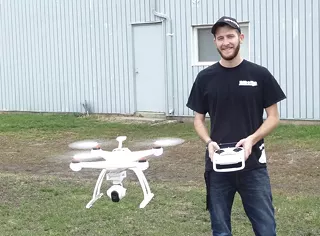by Job Conger
During the early evolution of internal combustion gasoline engines, it didn’t take long for inventors to hang one on a bicycle, resulting in the first motorcycle. Similarly, about three years ago, when the first multi-rotor and quad toy helicopters zoomed skyward from fertile minds, it didn’t take long for someone to hang a tiny video camera from one. Thus began a tumult of developments that has led the Federal Aviation Administration (FAA) to recognize and address a brushfire of threats to flying safety in the hope of preventing a conflagration. As airliners and other aircraft have collided with birds with unhappy consequences, the rising popularity of remotely controlled unmanned aerial systems (UAS) has prompted FAA efforts to minimize the risk with new rules and Mayor Jim Langfelder to recently propose a local ban. Rules are being formulated over the winter, and a formal doctrine will be made public sometime in 2016. The anticipated rules, along with new miniaturization technology, has led to a major surge in UAS popularity at the retail hobby store level.
Sales of those offered by Falcon Hobby Supply, 2875 N. Dirksen Parkway, have taken off in a big way since the store opened about two years ago. Manager Jess Wade explained that after many years in the “hobby business” exclusively over the Internet, he and owner Paul Carlson opened a storefront to serve central Illinois. The store also specializes in remote control trucks, airplanes and more. Paul’s son, Zach, is the shop’s manager.
“By definition, the term ‘drone’ applies to vehicles that fly without constant human input,” he said “The manufacturers sometimes call them ‘drones’ to appeal to customers who think that’s what they are. But all of the 20 or so multi-rotor and quad UASs we sell stop forward motion and go into hover mode if you release the controller.” Small ones without cameras sell for about $30. Basic camera-equipped models record the flight on memory cards which can be played back on a computer, and prices start at about $60. Larger ones transmit in real time to a controller screen or phone. Prices for those capable of business and commercial applications are considerably higher.
Some have a controllable range of 1.2 miles. The largest UAS offered by Falcon is the Inspire One, manufactured by DJI, at a cost of $3,400. It transmits the view to two controllers, an arrangement allowing one person to fly the UAS and the other person to control the camera. As word about growing FAA interest in UAS units spread, Carlson said, sales took off, thanks to people wanting to buy before the rules became official. “I expect to sell even more this Christmas season,” Carlson said.
Misconceptions about what a UAS can do are rampant. “People think you can use recreational models for spying,” he said. “Not true. They use miniature cameras with very wide-angle views. Even though the drone may be hovering just a few feet from you, the view extends much wider than you’d expect. They think that if your UAS is half a mile up, you can see everything at a particular house. That’s not how it looks. The technology is just not there.”
Current rules require users to maintain visual, line-of-sight awareness, but most UASs with real-time transmitting cameras have built-in capability that allows them to be flown beyond that restriction.
The FAA website (www.faa.gov/uav)states that any UAS weighing more than 55 pounds must be registered and licensed. Those offered at Falcon weigh nowhere near that much but the more capable ones have gimbals and stabilization gear, sometimes accounting for half the price of the vehicle. This eliminates the jerky motion of non-stabilized cameras. The best have GPS gear that allows precise positioning and navigation.
Quad drones are easier to fly than airplanes with cameras. “You can fly one with five minutes of instruction,” Carlson said. Batteries for larger drones with cameras take between one and two hours to charge. Smaller batteries charge in as little as five to 15 minutes while larger batteries can take one or two hours. Flight endurance of the larger ones is up to 30 minutes. “If you run out of battery power with an electric- powered airplane, it may glide out of sight. If the battery in a quad dies, it falls straight to the ground. If you’ve been flying line of sight, you know where it landed.” Carlson was too involved with the store to attend the summer FAA seminar, co-sponsored by the Illinois Department of Transportation’s Division of Aeronautics. “I have shared my thoughts with Stan Swank who’s the FAA UAS specialist,” he said.
“In terms of sales volume, I expect the UAS market to outpace radio-controlled model airplanes. They’re so much easier to fly.”
Until the FAA announcement of rules and regulations in 2016, the following basic guidelines apply: recreational UAS flyers may fly no higher than 400 feet from the ground. They must stay at least 25 feet from individuals and protected property. Businesses need approval for UAS flying. News media also need FAA approval. “Public entities” including publicly funded universities, police and fire departments must apply for a certificate of waiver or authorization to fly a UAS in public areas.
As for Mayor Langfelder’s recently announced plans for strict city-wide drone regulation, Carlson said he considers them “somewhat premature. I’ve read the document that lists concerns, and it shows limited understanding of what UAS can do.” For example, they mention infrared (IR) cameras and scopes. The cameras alone cost about $6,000, and they cannot penetrate solid objects. “The only possible application for IR commercial use is in agricultural photography,” he said. “Anyone who has ever heard a UAS (that’s available on the everyday market) knows that the noise of the rotors overpowers any sound that might reach a listening device.” He said he planned to visit the Nov. 24 public hearing and share his thoughts there.
For every rule shared on the FAA UAS website, there appear to be rules that amend each rule. “It’s a very gray area,” Carlson said. Linked from the FAA site is information posted by the Know Before You Fly organization where updated information will be shared as it comes. Its website is knowbeforeyoufly.org.
Job Conger can be reached at 544-6122 or writer@eosinc.com.















